Could BEAUTY AND THE BEAST cast its spell for cinematographer TOBIAS SCHLIESSLER and bring him awards recognition as he reteams for the fifth time with director Bill Condon for Disney’s BEAUTY AND THE BEAST? Working together since 1995 on films like “Dreamgirls”, “Mr. Holmes”, “The Fifth Estate” and “Candyman: Farewell to the Flesh”, BEAUTY AND THE BEAST marks their most ambitious project to date and one which Schliesser not only relishes, but cherishes.
Staying true to Gabrielle-Suzanne Barbot de Villeneuve’s 1740 “tale as old as time”, and in keeping with Disney’s beloved 1991 animated film which inspired this live-action interpretation, under the direction of Condon, Disney’s BEAUTY AND THE BEAST gets a 21st-century story tweaking, not to mention beautiful and breathtaking imagery, reflective in a true marriage between production design-costume design-cinematography. It is this triumvirate that makes BEAUTY AND THE BEAST as splendid as it is.
Production Designer Sarah Greenwood creates a set that is lush, rich, textured, and extraordinary with imagination and detail, while Costume Designer Jacqueline Durran delivers exquisite work that embraces not only the animated film, but 18th-century France, all of which is designed with cinematography in mind. And it is cinematographer TOBIAS SCHLIESSLER’s lighting and lensing, and particularly the lighting, which constantly changes, capturing the beauty and texture of the production design and costuming while complementing the story and character development, casting its own enchantment over BEAUTY AND THE BEAST.
During this exclusive interview with TOBIAS SCHLIESSLER, we talked about lighting and lensing the castle from LED light panels to Leica lenses and the Alexa XG camera, the constant changing of the castle in tune to the emotions of the Beast, using candlelight and moonlight as light sources, and, of course, the production numbers.
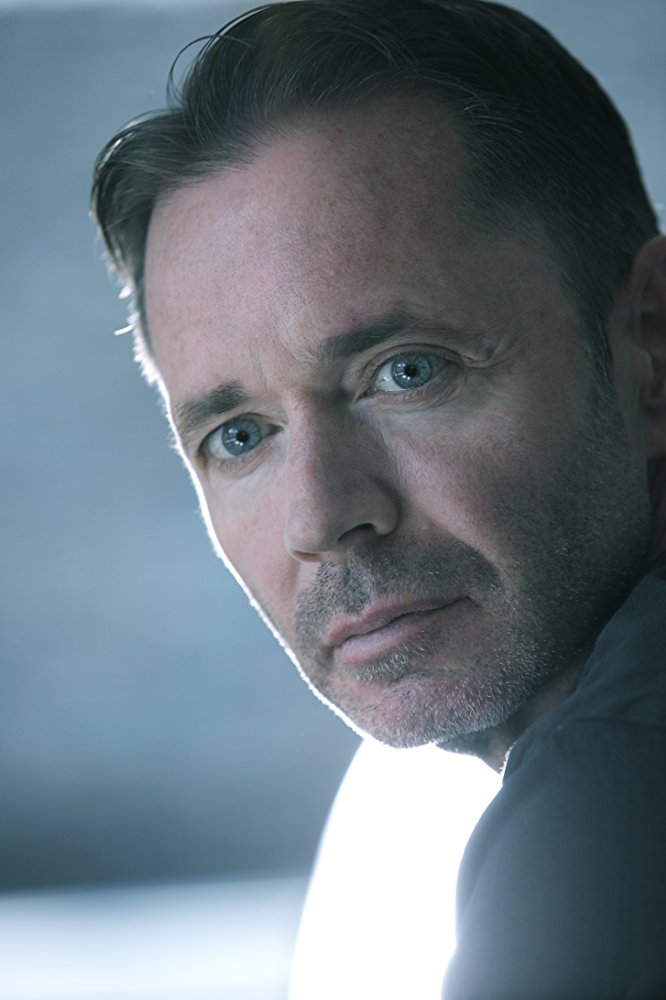
Your work on BEAUTY AND THE BEAST this year has been one of the highlights of cinema for me.
Oh, that’s great! Thank you so much! I’m glad you liked it. I find that I didn’t get that much critical love out there for that movie. I don’t know what it was, but I’m glad you liked it.

A real key to this film, Tobias, is the marriage between Sarah’s [Greenwood] production design, Jacqueline’s [Durran] costuming and your cinematography. I don’t remember a film where I have seen those three disciplines as integrated as in this film and I think a lot of it is because of the whole idea of the castle being alive and constantly in flux based on emotion.
Yeah. That’s what I felt. It was the most incredible experience for me working with the production designer and costume designer because I felt like they all were on the same page. When I first came on in prep, I walked through the art department, Sarah took me through it. I watched the illustrations that they had. I was like, “Wow, if I could just make this movie look like what they have already, in a way, designed, it’ll be amazing.” I think in the end the movie looked like that, so it was great. That was, for me, very satisfying that we were able to really put that look onto the movie.

In addition to just lensing the movie as a regular narrative, you have major Busby Berkeley-type production numbers going on in this film. Keenly, the film is really bookended by two of them, the opening number where the Prince becomes the Beast and the final production number where the Beast has become the Price. That’s really the book ending here. Let me start with the opening number. You essentially have three visual tones, three visual lighting schemes all within that one scene. I’m curious how you approached that. You’ve got candlelight, moonlight, darkness, but then the overall lighting. It’s not as bright and rich as when we get into the world of Belle. The Prince has his own sickly pallor that matches the powder on his skin. I’m curious about your approach to lighting and lensing the opening sequence.
I think that you’ve noticed that it was three different looks in one. It already came up in my talks with Bill [Condon] and Sarah [Greenwood] about this, but for me to achieve this was actually with one of the new techniques with the LED lighting because before that, it was pretty hard to change the look during an actual scene or during a shot. I was able with Kino Flos and Arri Skypanels, the new sky panel, I was able to change color temperature and level in a continuous shot. It was all done with dimmers, every light was always on dimmers, everything was on mainly LEDs. Coming into the movie, I thought I was going to light it more traditionally with old-fashioned Tungsten lights because of the period piece and the fairytale, but then in prep, changed it over because of those challenges of changing the overall lighting during a shot. We changed it all to LED lighting. It was one of the first movies where I’ve done this, so that was great. We talked about what we wanted to do with the scene, the colors. I don’t know if you noticed, for example, all the women’s gowns [in the opening production number] were all kind of the same color, but not. The costume design in that scene is incredible because every dress was made by a different dressmaker and it was one those things where I came in, I saw illustrations of that color, and basically replicated that. It’s one of my favorite scenes actually in terms of just overall lighting because it does change. The Enchantress comes in, she comes through those doors and then there’s the lightning and how it blows out the candles and it changes the light in the ballroom from one moment to the next.

And of course, and then you get moonlight, which I know is always very, very difficult to achieve.
It is one of the hardest things to do. It’s interesting that you know that too, because it’s up to everyone’s interpretation how dark moonlight is because our eyes get adjusted to it when we’re outside. But on film, you want to be able to see, but it’s such a fine line of how you stylize moonlight, and a lot of the lighting in this movie is just moonlight and just candlelight.

Granted, they’re the two favorite lights for women everywhere because we look good in both of them, but they are the hardest lights for a cinematographer and a gaffer.
One of my favorite lights in BEAUTY AND THE BEAST is when Belle cleans the window in the ballroom when it was all covered up still with blankets, and the candelabras were still on the ground. She cleaned the window and let sunlight through and the whole room changes in one shot. Which is, same kind of idea of changing the lighting from a darker, cooler place in the castle when she comes in and she’s changing the whole tone of the castle by letting sunlight come through. We move through from a cool color temperature to a warm color temperature.
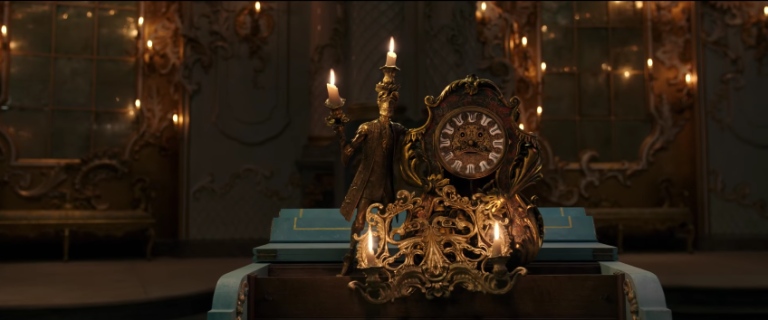
That is a beautiful transitional sequence as well, and it represents a great shift in the storytelling and in the tone of the film. When it came to designing your lensing, because you make very judicious use of close-ups, most of the film stays on wider shots, be it a mid-shot or a wide shot, that really lets us appreciate all of this beautiful Rococo design and Sarah’s production design, and all of the little intricacies with Katie Spencer’s set decoration. So I’m wondering, how did you go about designing your visual plan from a lensing standpoint.
Well, Bill always wanted to show as much of the production design as possible, and that’s why we went in and I used wider lenses as much as possible into a close-up. Not distorted wide lenses, but we would go in and use a 29 or a 35 mm. We were on the wider lenses to keep our actors in the space instead of using longer lenses where you throw the focus out and you wouldn’t see the set. The set was so beautiful that we really wanted to show them off in a sense and make the characters live in those spaces. Bill is very wise in terms of where he wants to go in for a close-up. He doesn’t do it for every shot. He uses it at the right moment so he doesn’t overload the audience by having close-up after close-up after close-up, which I find it happens a lot in movies nowadays. That was one of the things that we talked about right from the beginning, was that we didn’t want to have those extreme close-ups all the time.
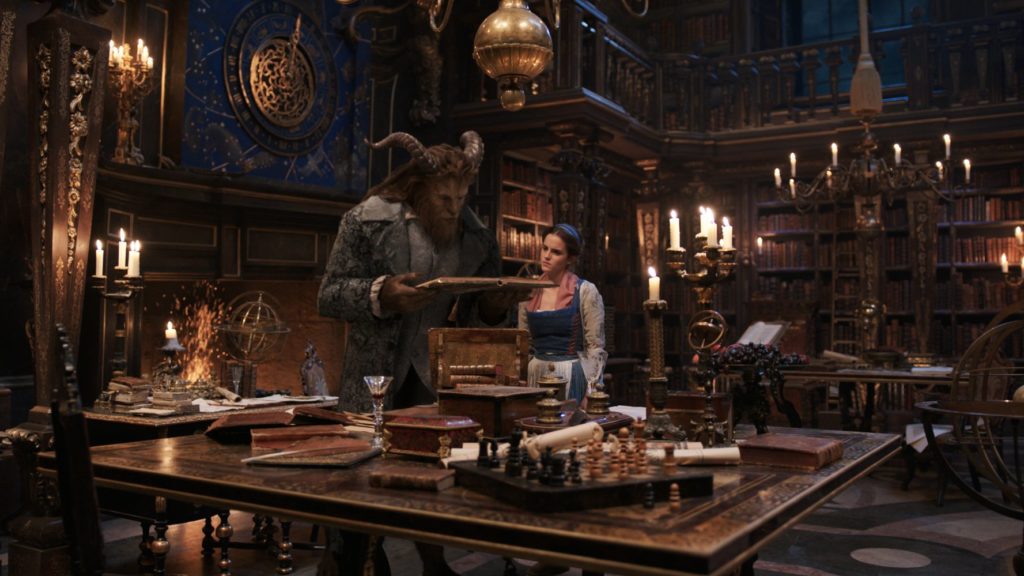
I think that’s very important in the storytelling here with BEAUTY AND THE BEAST because we get so much emotion from what’s happening around a principal character. From the castle itself, we get to see the castle react in an emotional state. And with close-ups, we would miss all of that otherwise.
That was definitely one of the strong points that Bill had in mind before we started. The lensing for a lot of the choreography and dance sequences – – – I have a shorthand with Bill. We’ve done three films together and we know how important it is to put the camera to the right place to show the choreography because you can be off by centimeters, inches, where you put your camera, and it doesn’t show off the choreography or the dance sequences as well as if you put the camera in the right place. We go off and we shoot all the dance rehearsals beforehand on tape and cut them together and find where the right angles are for those.

Now with a lot of these production numbers, especially the opening number, the final production number, and “Be Our Guest”, I’m seeing a lot of crane work here. I see a lot of cranes and for some of these shots, I’m also wondering if some drones came in to use.
No, we didn’t use any drones. It was all done off Technocranes. Well, not Techno. It was the Hydrascope from Chapman. But we had the 70-foot one, we had the 40-foot, the 20-foot. There was no drone work. Again I was very lucky, because it is very important to the motion of the camera in terms of musical, to be in tune with the music and be on the rhythm of the music. I had a very musical-oriented key grip. My dolly grip, he was just so good with the pacing of the shots. And the same thing with my camera operator, they both had a really good feel for music and that’s so important when you’re shooting musical numbers.
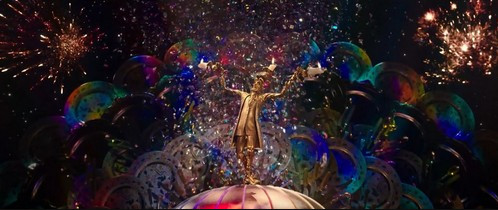
Speaking of musical numbers, I have to ask you about the “Be Our Guest” number. That is a showstopper. I have said since the first moment I saw it that it could be its own short film. It is pure joy, it is a delight, it is an homage to classic Hollywood and to Broadway and it is so theatrically done that with the lighting it appears linked to the actual music, very similar to what Minnelli did in “An American in Paris.”
I have to give credit to someone on this. Bill knew exactly what he wanted from that. That was his number one number that he pre-vis-ed every detail. We also had Jules Fisher and Peggy Eisenhauer. They’re theatrical lighting designers. They worked with us on “Dreamgirls” and they came in to really design the lighting for that sequence. I cannot take the credit. I can take the credit of making their vision come onto film and make it work, like how much the exposure is for the colors, and how much the exposure is for this and that. But the actual lighting design of that scene is done by them, because no one’s better than them. And Bill knows that. It’s an homage to all the lighting that they’ve done, so it’s kind of their lighting number, for sure.
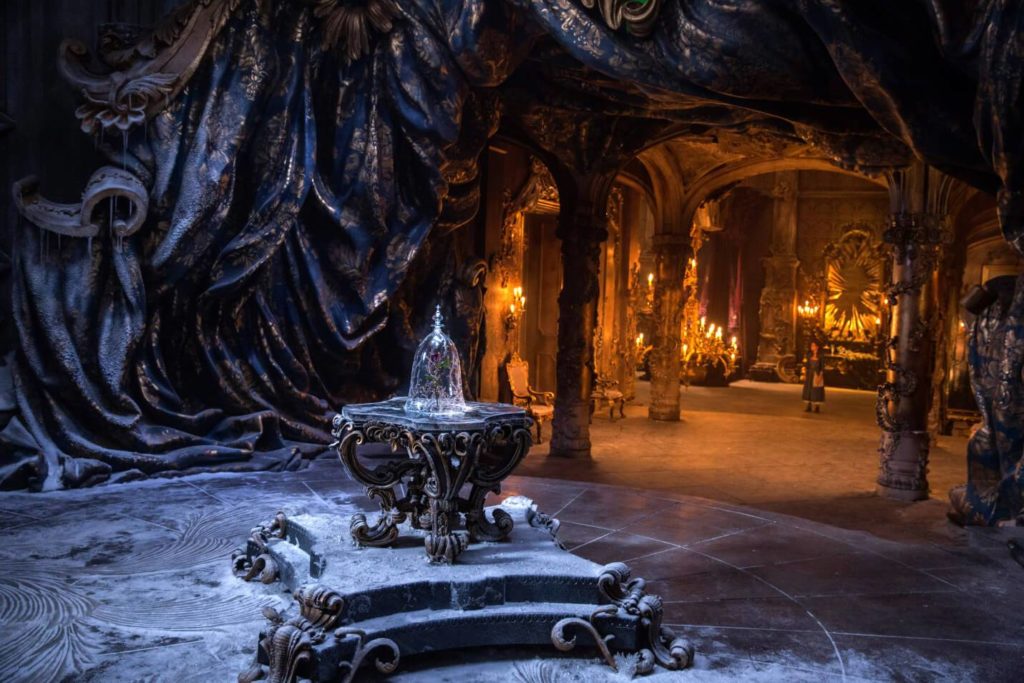
The lensing is beautiful and then it’s blended with the CGI, and it’s a kaleidoscopic explosion of pure joy. I love it.
I know, right? It is incredible.

I’m curious, what cameras and lenses were you shooting on for this film, Tobias?
I used the Arriflex Alexa XG camera and I went and tested out every lens possible. We didn’t want to go anamorphic because we wanted to keep the focus deeper. In anamorphic it gets shallow focus. Because we wanted to show the sets, we went with spherical lenses. But I went and tested every single lens beforehand in terms of how they reacted towards candlelight because a lot of times I wanted candles to be the light source in the scene. For example, when Belle walks through the prison tower and she had real candles in her hand that would light her sometimes. So I tested all the lenses, which ones would react best to actual candles, because some of them glare a little bit more. So I ended up using the Leica lenses, the Primes, for most of the movie.

You can never go wrong with Leica. And the thing is, with your Leica, you also get truer and richer colors, I think.
They’re very amazing. They were the high-speed lenses, the 1.4s. That was the thing. The blacks were amazing. The Leica Summilux-C lenses, I thought that they took the highlights of the candles really well. They’re nice on skin tones. They were definitely the right lenses for that movie.

While the bulk of this film was shot on the soundstages at Shepperton, you also had some forest scenes that were exterior, that were actual live exteriors, correct?
Most of it was onstage, even the enchanted forest where the wolves were chasing Belle, and everything around the castle, that was all on stage. We had a huge, huge stage at Shepperton that they built a real forest in. There was only one scene when Belle’s father comes, when he first is on his way to the castle, and the lightning strike hits that tree. That was done on a real forest, but that was the only time. We only shot like three or four days on location, in a forest, and the rest was all done on stage. And the French village was a backlot as well.
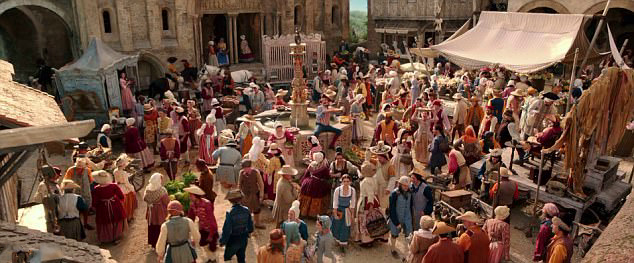
The French village is absolutely beautiful. How did you go about designing the lensing on that, because here again, you have a beautiful production number there, that for me, it reminded me of the huge “Consider Yourself” number back in 1969’s “Oliver.” But your lighting is so beautiful. It is like an honest-to-God, beautiful sunlit day in the French countryside.
We wanted to have it feel this warm feeling of early morning light, and of course we had to shoot all day. Of course the one time in London when it is sunny every day in the summertime was when we were shooting. But I was able to soak in the whole village. Half the village was done with a cable rig of silks and then I also had three 55-50 frames at the same time that would patch in areas where we couldn’t cable rig the whole circuit. Then I had surrounded the whole village with a mixture of Tungsten light and HMIs. I kind of mixed daylight and Tungsten, the warm Tungsten, kind of together to get that early morning feel.

And it also gives you that European feel too, that we don’t often see here in the United States or in California. There’s a certain depth to the diffusion of light in Europe.
In a sense, we took all the sun away and used the silks as an ambient light and then give the highlights with Tungsten and HMI, so it was very controlled, that whole village was very controlled. Then in terms of lensing everything, we’d go out with Bill and we rehearsed all those scenes beforehand and just found the right lenses and the right moves and pacing of the moves and everything. For example, there’s one shot that goes around 360 around Belle when all the other women with the flowers come around and she starts being engulfed, surrounded by all these flowers and colors and everything, and then we come back out of it again. A lot of it is obviously Bill’s vision, he was very clear on this movie, what he wanted.

How exciting is it for you, Tobias, as a cinematographer, to work on a film like BEAUTY AND THE BEAST? When I look at the other films that you’ve done in your career, I see pieces of each one of them and the disciplines you employed there, I see them all come together in this film. This film is like a testament to your body of work, where you got to draw on the beauty and the clarity that we saw in “Mr. Holmes”, and working with music and production numbers in “Dreamgirls”, but then the darkness of “Lone Survivor.” All of this experience has come together so beautifully here. How gratifying or how challenging is it, and how exciting is it, when you get a project like this?
It’s so exciting. I said that when I was doing the movie, it really doesn’t get any better than that, and especially if you have a relationship with a director that trusts you and that you have a shorthand with. Bill involves me in all the storyboarding, Bill involves me in all the pre-vises, so it is an incredible collaboration which is great. I’m very lucky. I’ve had the same kind of relationship with Peter Berg, who is a completely opposite filmmaker than Condon is with movies like “Lone Survivor” and “Friday Night Lights”. They’re both different challenges, but I love the idea of being able to do different styles. A lot of people come to me and go like, “Wow, how can you go on such two different type of movies, or different styles?” And I find that very gratifying. I was ready for this movie. I felt like, okay I really understand the craft of the cinematographer and I felt comfortable in this movie, taking on big challenges and not being afraid of them. Some of the scenes had over 2,000 [inaudible 00:21:48]. It was such intricate lighting sometimes that I felt confident, so yeah. I was ready for this movie.
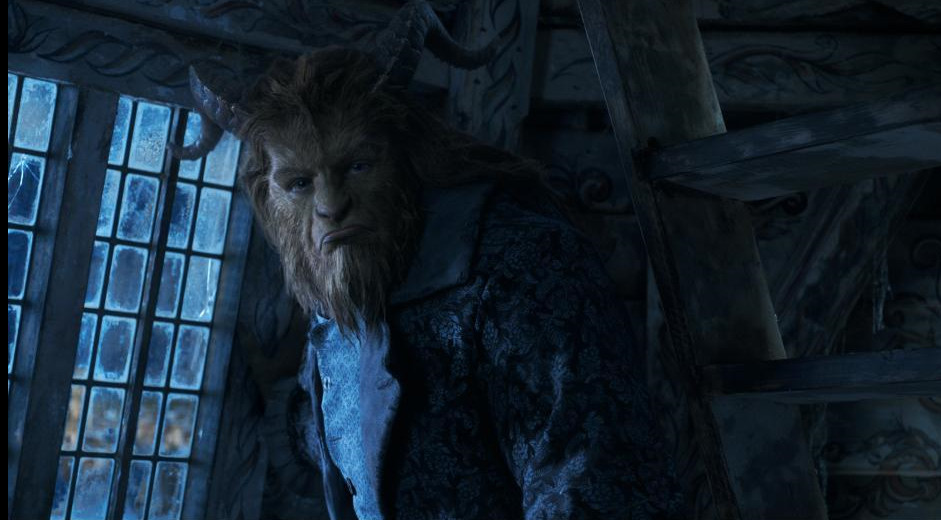
How many cameras were you shooting throughout this?
Mostly two. For all the musicals obviously we had three cameras but during the shooting, for all the scenes we had two cameras. I would say we shot 60 percent with one camera, 50% with one and the other 40 and then it was like 10 percent of the movie was with three cameras. It’s nice to use a second camera for continuity, cut-ins in the scene. You have to use two cameras for musical numbers, right, because you can’t have your actors perform over and over again. But I don’t mind using two cameras or three cameras. I can usually design my lighting around it to make it work. That’s what I kind of learned from Pete Berg. He’s a three-camera kind of director all the time and so I’ve learned over the years to make it work.

Well, you certainly made it work with this one, Tobias. This is truly, and I have maintained this since the beginning of the year, this is exemplary cinematography. It is one of the best films of the year. It is the best thing that you have done to date. Of course now, now I gotta hold you up to really high standard with your next film, “A Wrinkle in Time.” That is my all-time favorite book, so I’m gonna be watching that one really closely. I can’t wait to see how you light, how it was designed, how you light Camazotz and some of the other really incredible places in that story.
Okay! That’s a big challenge, that one. That was a big challenge, that movie, too. I’m actually going to see it for the first time next week and I’m excited to do that. We have a couple days of pickups to do in the first week of November and I hear good things about it. I can’t give you my opinion yet because I haven’t seen it yet but it was wonderful to work with Ava DuVernay. I had a great time with her, and it was very collaborative too, so I have high hopes for the movie. I thank you so much. I am so honored that you liked BEAUTY AND THE BEAST so much and that you like my work so much. Thank you so much.
By debbie elias, interview 10/20/2017











